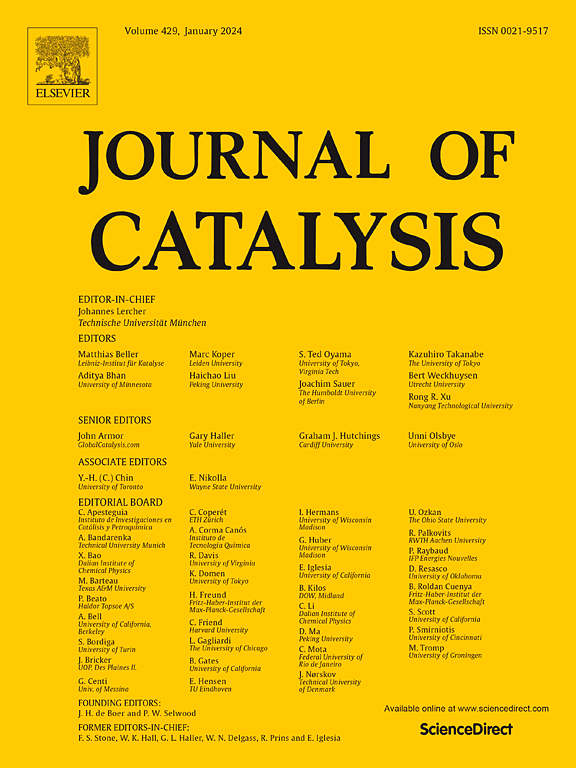阐明Ziegler-Natta催化反应中活性物质与聚乙烯分支分布的关系
IF 6.5
1区 化学
Q2 CHEMISTRY, PHYSICAL
引用次数: 0
摘要
采用Ziegler-Natta催化剂合成的乙烯/α-烯烃共聚物在低分子量段具有较高的短链支(SCB)浓度,影响了最终产物的力学性能。在此,我们在分子水平上研究SCB分布起源的机制。我们设计了一种球形催化剂,将两种具有不同迁移率的醇结合在一起,然后通过增加TiCl4负载的第二步钛化来驱动醇分子的迁移。这种迁移不仅导致醇类从催化剂表面逸出,而且导致醇类与Ti中心的配位,从而调节活性物质在催化剂表面的迁移率。我们证明了钛的聚集行为是由它们与MgCl2表面的键合决定的,在三乙基铝活化过程中,无论是ticl3类簇还是分离的Ti3+位点都可以优先合成。进一步的聚合结果结合电子顺磁共振分析表明,ticl3类簇和“休眠”活性物质有助于SCB在不同分子量上的均匀分布,而MgCl2(110)平面上的主要分离Ti3+位点将SCB集中在合成的聚乙烯的低分子量部分。综上所述,我们揭示了聚合物分支分布和催化结构之间的相关性,并表明后者可以通过调整醇的迁移来调节。本文章由计算机程序翻译,如有差异,请以英文原文为准。


Elucidating the correlation between active species and branch distribution of polyethylene in Ziegler-Natta catalysis
The ethylene/α-olefin copolymers synthesized by Ziegler-Natta catalysts generally exhibit much higher Short-Chain Branch (SCB) concentration in the low-molecular-weight fraction, which hampers the mechanical properties of the final products. Herein, we investigate the mechanism underlying the origin of SCB distribution at a molecular level. We design a spherical catalyst combining two alcohols with different mobility, after which a second titanation step with incremental TiCl4 loading is applied to drive the migration of alcohol molecules. This migration induces not only the escape of alcohols from the catalyst surface but also the coordination of alcohols with Ti centers, which regulates the mobility of active species on the catalyst surface. We demonstrate that the aggregation behavior of Ti species is directed by their bonding to the MgCl2 surface, where either TiCl3-like clusters or isolated Ti3+ sites can be preferentially synthesized during triethylaluminium activation. Further polymerization results combined with electron paramagnetic resonance analysis show that TiCl3-like clusters and the “dormant” active species contribute to the uniform SCB distribution over different molecular weights, whereas the predominated isolated Ti3+ sites on the MgCl2 (110) plane concentrate the SCB in the low-molecular-weight fraction of the synthesized polyethylene. Taken together, we reveal a correlation between polymer branching distribution and catalytic structures, and show that the latter can be regulated by tailoring the migration of alcohols.
求助全文
通过发布文献求助,成功后即可免费获取论文全文。
去求助
来源期刊

Journal of Catalysis
工程技术-工程:化工
CiteScore
12.30
自引率
5.50%
发文量
447
审稿时长
31 days
期刊介绍:
The Journal of Catalysis publishes scholarly articles on both heterogeneous and homogeneous catalysis, covering a wide range of chemical transformations. These include various types of catalysis, such as those mediated by photons, plasmons, and electrons. The focus of the studies is to understand the relationship between catalytic function and the underlying chemical properties of surfaces and metal complexes.
The articles in the journal offer innovative concepts and explore the synthesis and kinetics of inorganic solids and homogeneous complexes. Furthermore, they discuss spectroscopic techniques for characterizing catalysts, investigate the interaction of probes and reacting species with catalysts, and employ theoretical methods.
The research presented in the journal should have direct relevance to the field of catalytic processes, addressing either fundamental aspects or applications of catalysis.
 求助内容:
求助内容: 应助结果提醒方式:
应助结果提醒方式:


